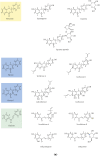Antidepressant effect of licorice total flavonoids and liquiritin: A review
- PMID: 38074876
- PMCID: PMC10700396
- DOI: 10.1016/j.heliyon.2023.e22251
Antidepressant effect of licorice total flavonoids and liquiritin: A review
Abstract
With the development of society and changes in lifestyle, major depressive disorder (MDD) has become a significant disease that plagues many people. Licorice, an excellent natural medicine with a long history of cultivation and application, is found in classical antidepressant prescriptions such as Chaihu Shugan Powder, Ganmai Dazao Decoction, Suanzaoren Decoction, etc. Licorice mainly contains triterpenoids and flavonoids, among which licorice total flavonoids (LF) and liquiritin are the main active components with good antidepressant effects. The pharmacological effects of licorice have been extensively investigated in current studies. However, a review of the antidepressant effects of LF and liquiritin has not been conducted. This article reviews the antidepressant effects of LF and liquiritin, including the biological characteristics of licorice and the pharmacological mechanism of LF and liquiritin in treating MDD. Studies have shown that LF and liquiritin can exert their antidepressant effects by improving depressive behavior, regulating endocrine and hypothalamic-pituitary-adrenal (HPA) axis function, affecting the brain-derived neurotrophic factor (BDNF)/tyrosine kinase B (TrkB) signaling pathway, enhancing synaptic plasticity, increasing monoamine neurotransmitter levels, protecting nerve cells, reducing inflammation, preventing apoptosis, reducing oxidation and other ways. This lays a theoretical foundation for the development of antidepressant drugs.
Keywords: Antidepressant; Licorice total flavonoids; Liquiritin; Major depressive disorder.
© 2023 The Authors. Published by Elsevier Ltd.
Conflict of interest statement
The authors declare that they have no known competing financial interests or personal relationships that could have appeared to influence the work reported in this paper.
Figures



References
Publication types
LinkOut - more resources
Full Text Sources

